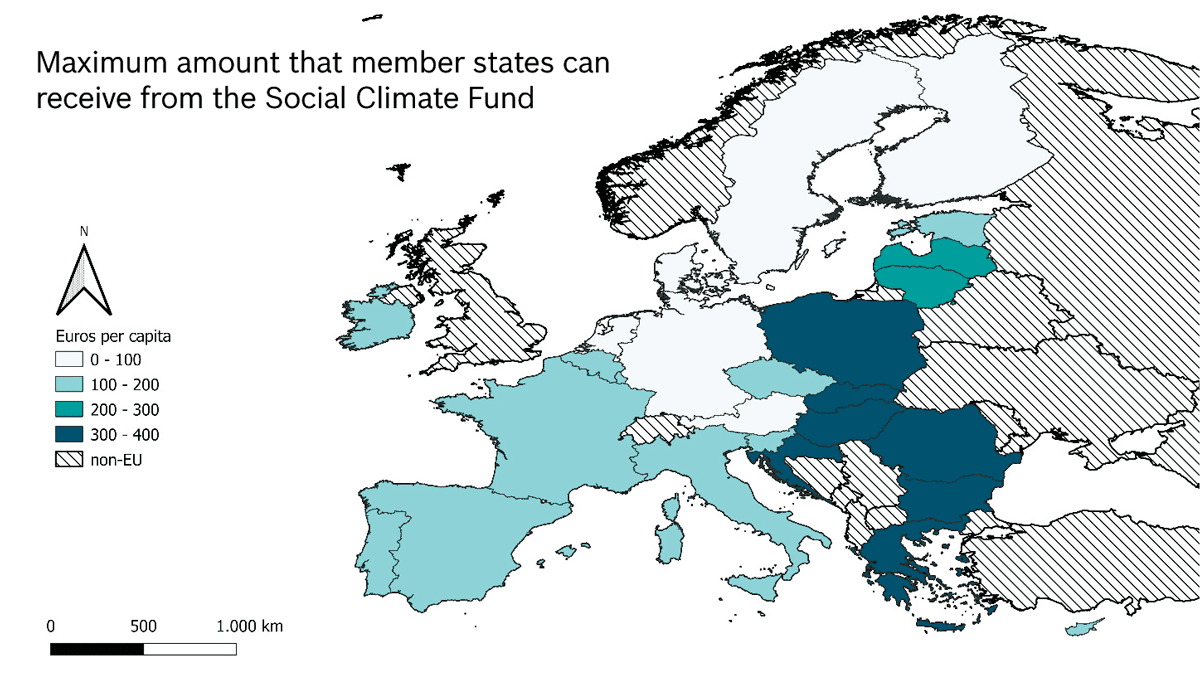A Social Climate Fund for People
The report on setting up the Social Climate Fund (SCF) was adopted in mid-May during a joint meeting MEPs in the Committee on Employment and Social Affairs and those of the Committee on Environment, Public Health and Food Safety. This is the first step for materializing the proposal to set up a special fund, with a value of EUR 72.2 billion. The step is aimed at offsetting the social impact generated by European Union’s ambitions in the field of decarbonization. The fund would become operational in 2025 and work until 2032. In essence, it is designed to reduce the social burden caused by the negative impact on prices of including the building and road transport sectors in the EU Emissions Trading Scheme (ETS).
The Social Climate Fund will be tasked to support EU citizens, should the Green Deal measures lead to higher bills or other unwanted effects. The fund will provide funding to Member States to support the measures of offsetting the increase in utility bills and investments in Increasing the energy efficiency of buildings, decarbonization of heating and cooling of buildings, including integration of energy from renewable sources and granting an improved access to zero and low emission mobility. These measures will mainly benefit vulnerable households, micro-enterprises, and users of the transport service.
“This is about climate change, but also about people,” Dragos Pislaru, the Chair of the Parliament’s Employment and Social Affairs Committee, commented.
Price increases will be high
The inclusion of the building and road transport sectors in the ETS system will have a significant financial impact in terms of prices. Basically, a new element will be introduced in costs, the price of CO2 allowances, and the possibility for those targeted to change their situation is very limited or even non-existent, the European Economic and Social Committee (EESC) said at the end of last year. Therefore, higher energy and mobility costs will deepen energy poverty. The inclusion of road transport in this system was made despite the reluctance of the private environment, trade unions and NGOs. The effects will be strong, especially on households which for financial reasons cannot choose an electric vehicle or a vehicle based on alternative fuels. Heavy vehicle carriers will also be hit, given that, at least for long distances, no real alternatives to fossil fuels are available, EESC also pointed out. EESC also drew attention to the fact that the questions whether the zero emission products will become attractive enough to offset the difference in cost caused by ETS or whether measures would be introduced on international markets with cost effects equivalent to those of ETS remain valid. If this is not the case, the competitiveness of European enterprises on global markets may become problematic.
Those in the European’s People Party (EPP) are strongly supportive of the idea. “Carbon pricing is crucial” to reduce emissions in road transport and buildings, said German lawmaker Peter Liese. But others are less convinced, saying the social climate fund should be separated from plans to create a new Emissions Trading Scheme for transport and buildings. According to the Commission’s proposal, the second ETS would initially be kept separate from the current carbon market, which covers emissions from industry and the power sector.
“We believe that the Parliament’s position must be to cut the link between the ETS extension and a social climate fund to enable the social climate fund to be funded by other means, like for instance, the ETS one,” said green lawmaker Michael Bloss.
“If there’s no extension of the ETS, which brings fresh money to the budget, there will be no new own resources,” noted Andreas Schwarz, an EU official working at the European Commission’s budget directorate.
“And if there are no new own resources, there will be no agreement in Council on the financing of the social climate fund,” he warned lawmakers.
Funding for energy efficiency
The fund will provide financial support for investments that aim, among other things, at increasing energy efficiency and renovating buildings. EU states will therefore be able to ask for money from the Social Climate Fund to support the renovation of buildings, including in the form of financial support or tax incentives, such as deductibility of renovation costs in rent, irrespective of the right of ownership over the buildings in question. Moreover, the states will be able to receive money for decarbonization by giving up gas for building heating and cooking and switching to electric systems, including by integrating energy from renewable sources. Member States will also be able to include in the applications for funding the costs generated by the measures that provide a temporary direct financial support to members of vulnerable households that use public transport, such as granting gratuities and discounts. Also in the transport area, the fund will finance increased access to zero-emission and low-emission vehicles and bicycles, EU countries being able to provide financial support or tax incentives for their purchase, as well as for the creation of electric vehicle charging station infrastructure.
Instead, measures providing for state intervention in setting gas supply prices will be excluded from funding. However, the Fund’s operating regulation provides that if a Member State demonstrates that the interventions do not fully compensate for the increase in prices resulting from the inclusion of the building and road transport sectors in the scope of Directive 2003/87/EC establishing a scheme for greenhouse gas emission allowance trading, direct support may be included in the estimated total costs within the limits of price increases which are not fully offset.
Economic analysts are skeptical
The money that would constitute this fund will come from trading in emissions allowances in the field of buildings and road transport. This means that the public money raised would go to offset the negative effects generated. However, analysts point out that this money should rather be used to invest in sustainable renewable energy, sustainable transport, such as cycling infrastructure and energy efficiency measures, which will lead to achieving the EU’s climate and energy targets set for 2030 and, in the future, by 2050. In this way, the Social Climate Fund would be a driver for change, not a safety net against the social risks that may arise. The financial envelope of the fund is EUR 23.7 billion for the period 2025-2027 and EUR 48.5 billion for the period 2028-2032, which corresponds, in principle, to 25% of the revenue expected to be accrued from auctioning of emission allowances under the emissions trading scheme for buildings and road transport. Member States will also contribute with at least 50% of the total estimated costs of their plans.
How will the money be allocated?
Financial allocations to each EU Member State will be made on the basis of agreed milestones and targets and included in national plans to mitigate the social impact of climate action. To this end, Member States will have to draw up investment plans and estimated costs, which will be evaluated and approved by the European Commission. Payment of the financial allocation will take place after the milestones and targets agreed with the Member State concerned have been met and made binding by a Commission Implementing Decision. Countries may request a payment from the fund once or twice a year, which must be accompanied by evidence of achievement of the targets assumed.
Calculation method
The methodology for calculating the maximum financial allocation for each country will take into account the following variables:
- Population at risk of poverty living in rural areas (2019);
- Carbon dioxide emissions generated by burning fuels by households (average for the period 2016-2018);
- Percentage of households at risk of poverty that have arrears on the payment of utility bills (2019);
- Total population (2019);
- GNI (per capita income of the Member State), measured according to the purchasing power standard (2019);
- Share of reference emissions under Article 4(2) of Regulation (EU) 2018/842 for sectors covered by Chapter IV of Directive 2003/87/EC (average for the period 2016-2018).
Investments of EUR 350 billion per year
The European Commission has estimated that an additional EUR 350 billion will be invested annually in the energy system by 2030 to meet the EU’s goal of reducing net carbon emissions by at least 55% from 1990 levels and achieve an emission-neutral economy by 2050. Of these investments, about EUR 130 billion are expected to be invested in the transport sector and EUR 110 billion in the building sector.







